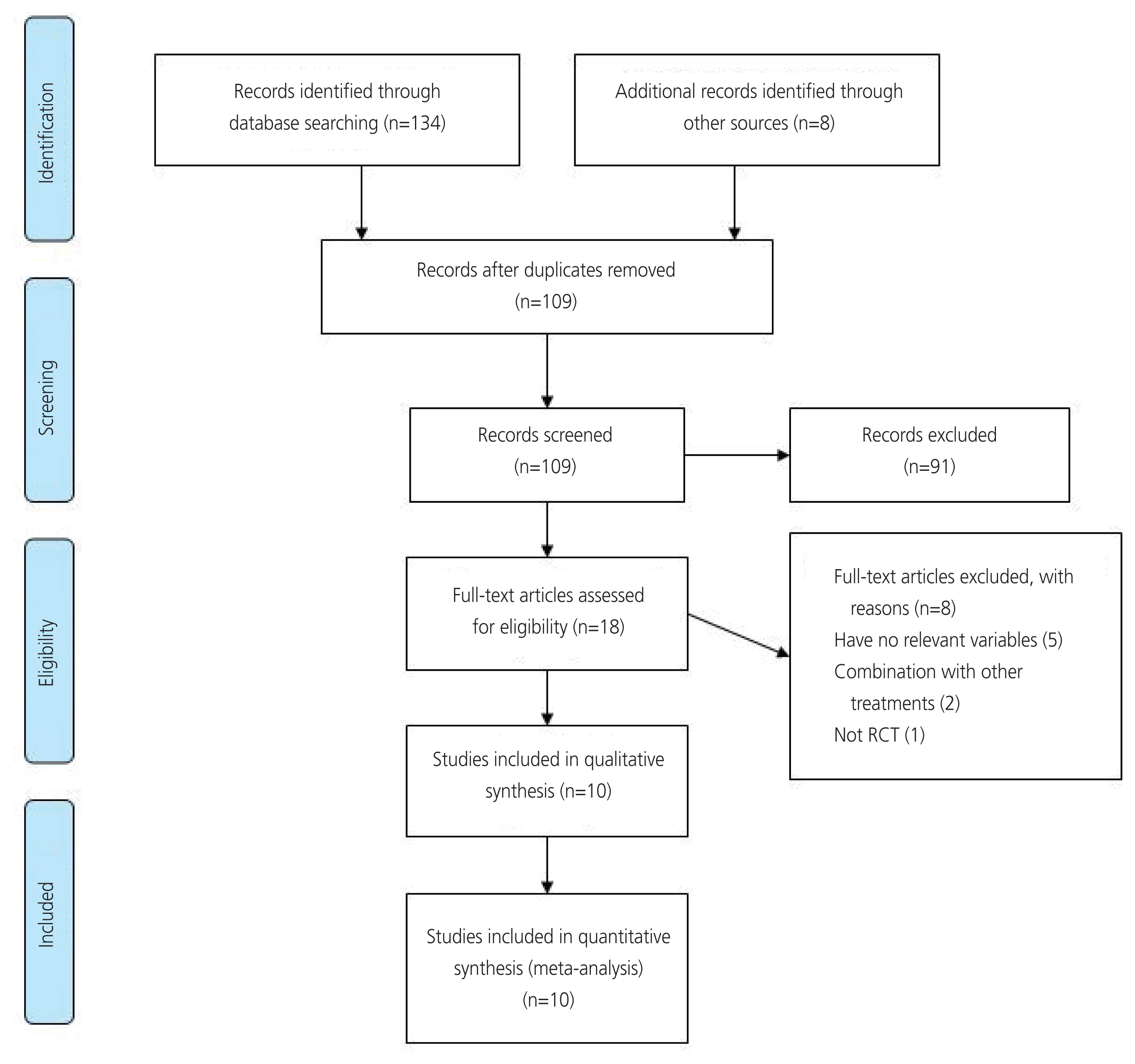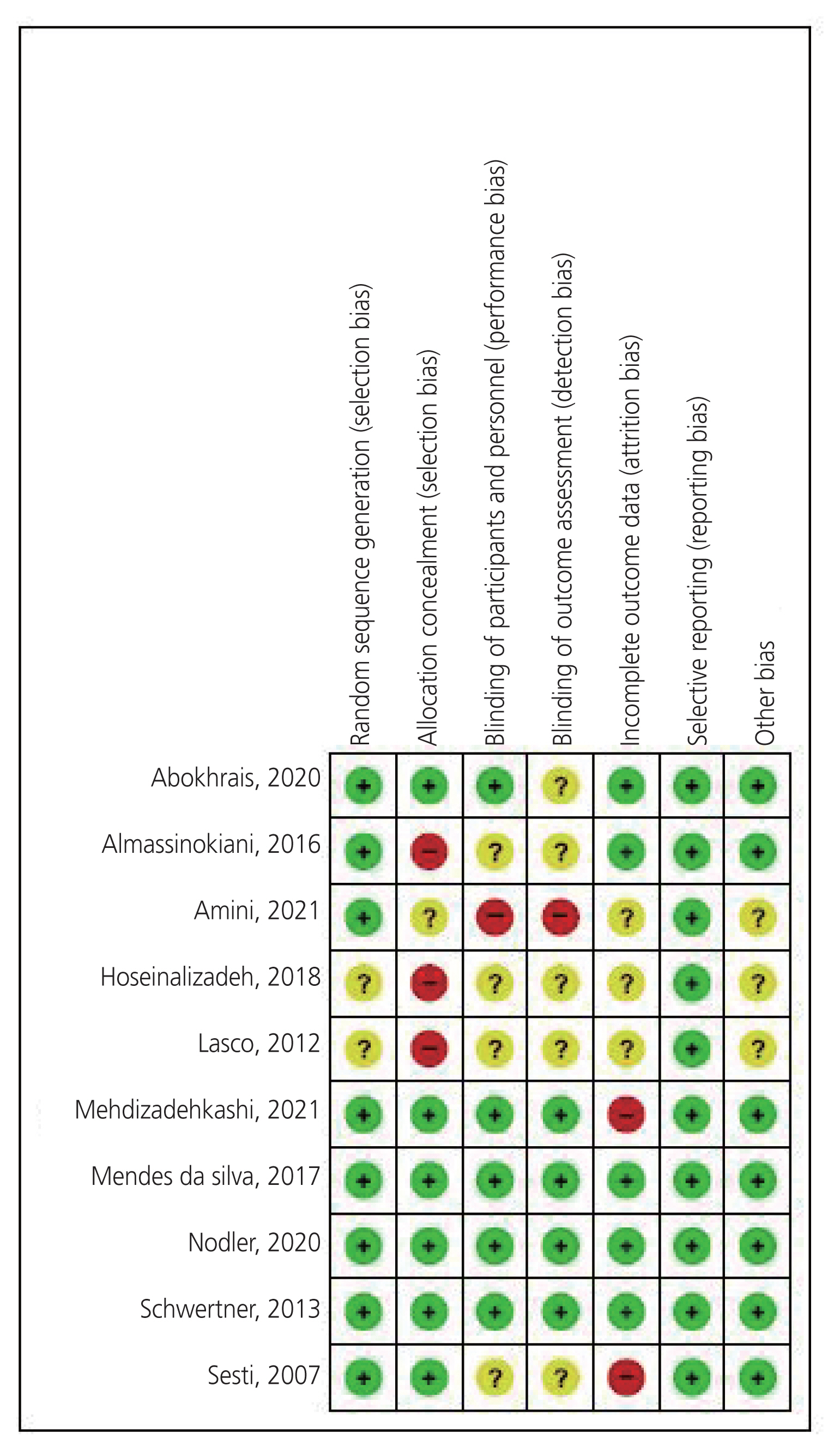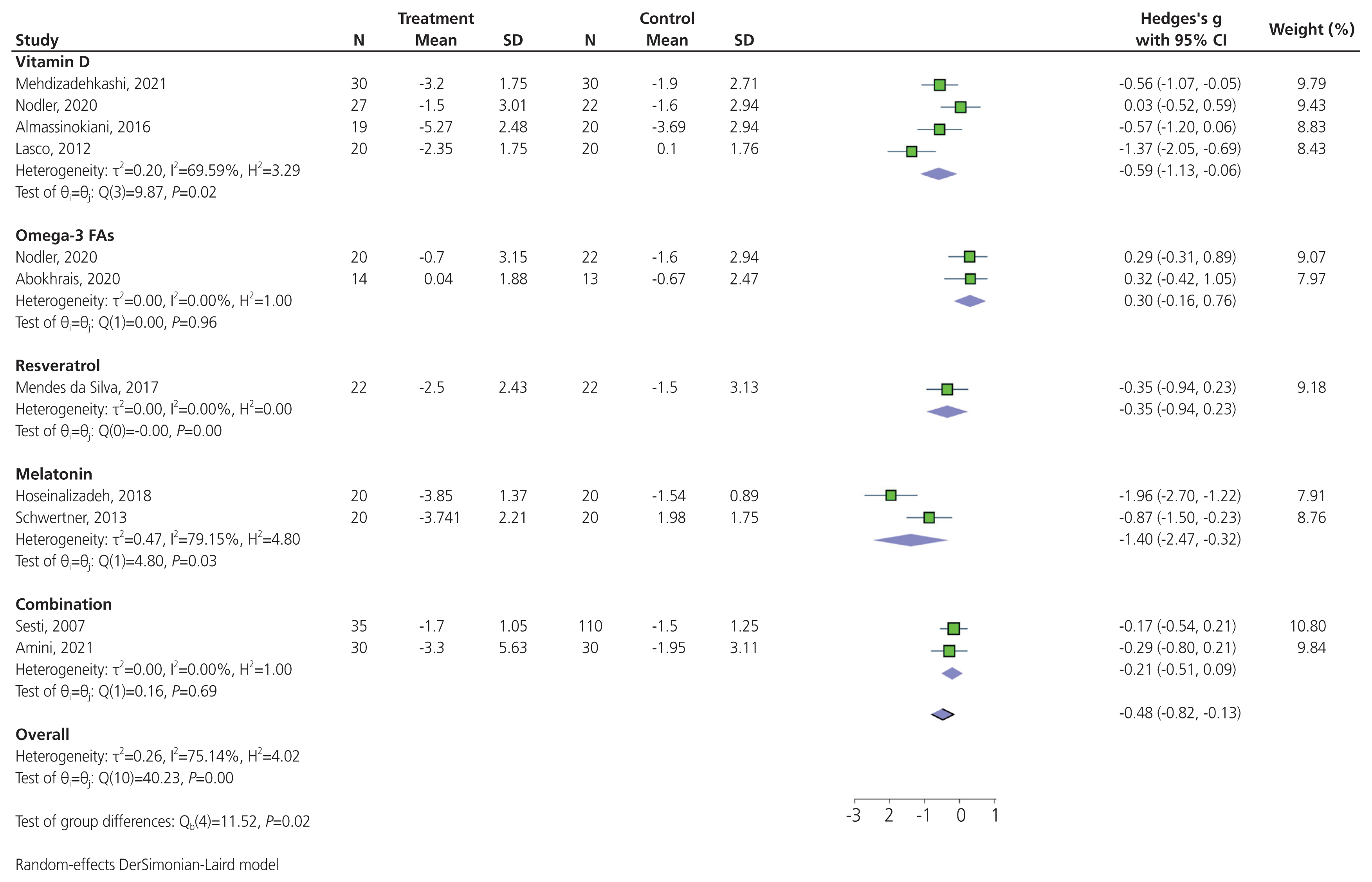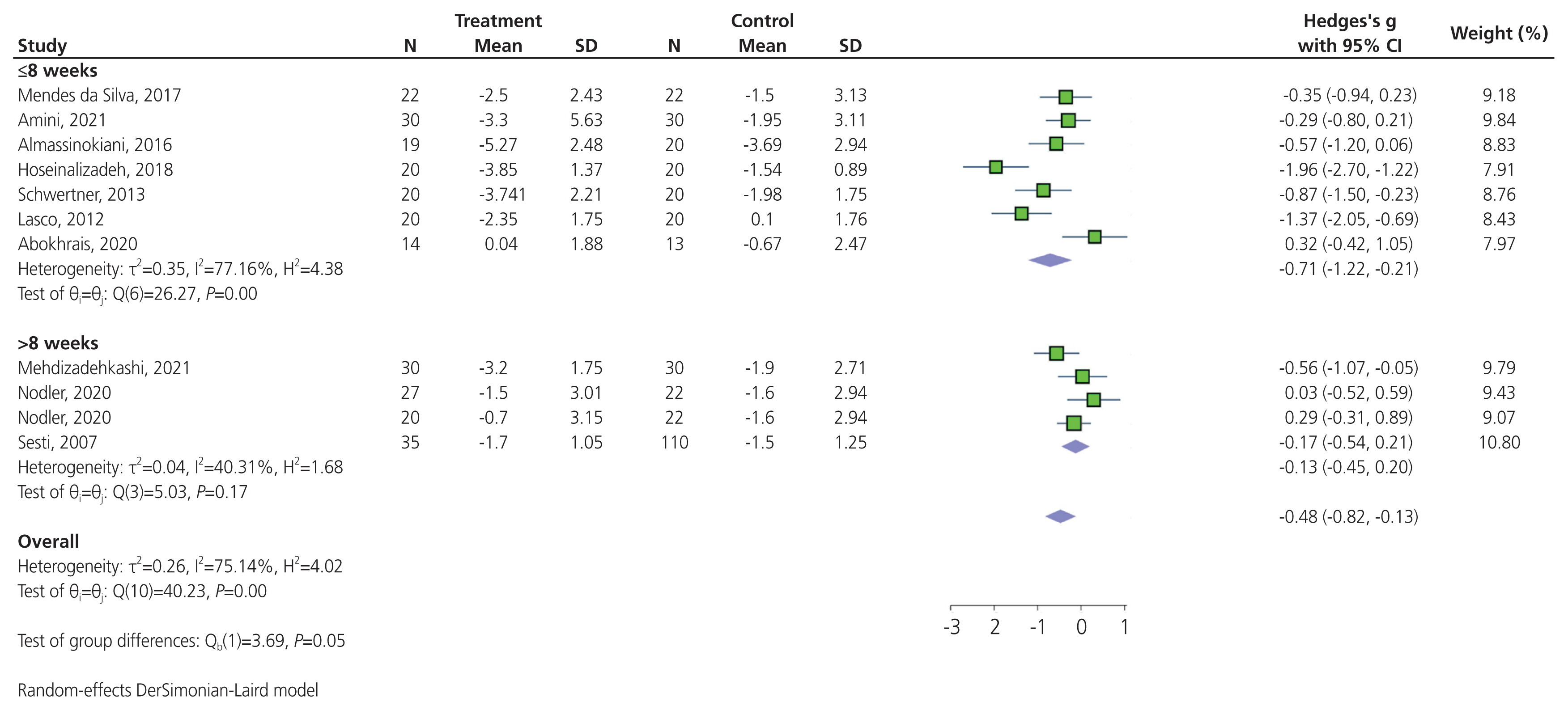Obstet Gynecol Sci.
2024 Mar;67(2):186-198. 10.5468/ogs.23210.
The effect of antioxidant supplementation on dysmenorrhea and endometriosis-associated painful symptoms: a systematic review and meta-analysis of randomized clinical trials
- Affiliations
-
- 1Department of Obstetrics and Gynecology, King Faisal Specialist Hospital and Research Center, Jeddah, Saudi Arabia
- 2Department of Obstetrics and Gynecology, College of Medicine, Umm Al-Qura University, Makkah, Saudi Arabia
- 3Department of Obstetrics and Gynecology, Al Salama Hospital, Jeddah, Saudi Arabia
- 4Department of Obstetrics and Gynecology, Faculty of Medicine at Rabigh, King Abdulaziz University, Rabigh, Saudi Arabia
- 5Department of Obstetrics and Gynecology, Faculty of Medicine, Najran University, Najran, Saudi Arabia
- 6Department of Obstetrics and Gynecology, College of Medicine, Princess Nourah bint Abdulrahman University, Riyadh, Saudi Arabia
- 7Department of Obstetrics and Gynecology, King Abdullah bin Abdulaziz University Hospital, Riyadh, Saudi Arabia
- 8Department of Obstetrics and Gynecology, College of Medicine, Alfaisal University, Riyadh, Saudi Arabia
- KMID: 2553426
- DOI: http://doi.org/10.5468/ogs.23210
Abstract
- This study aimed to review randomized controlled trials (RCTs) investigating the effects of dietary antioxidant supplements on the severity of endometriosis-related pain symptoms. The PubMed/Medline, Scopus, and Web of Science databases were searched until April 2022. Additionally, we manually searched the reference lists. Endpoints were summarized as standardized mean difference (SMD) with 95% confidence intervals (CIs) in a random-effects model. The I2 statistic was used to assess heterogeneity. Ten RCTs were included in this meta-analysis. Overall, 10 studies were related to dysmenorrhea, four to dyspareunia, and four to pelvic pain. Antioxidants significantly reduced dysmenorrhea (SMD, -0.48; 95% CI, -0.82 to -0.13; I2=75.14%). In a subgroup analysis, a significant reduction of dysmenorrhea was observed only in a subset of trials that administered vitamin D (SMD, -0.59; 95% CI, -1.13 to -0.06; I2=69.59%) and melatonin (SMD, -1.40; 95% CI, -2.47 to -0.32; I2=79.15%). Meta-analysis results also suggested that antioxidant supplementation significantly improved pelvic pain (SMD, -1.51; 95% CI, -2.74 to -0.29; I2=93.96%), although they seem not to have a significant beneficial impact on the severity of dyspareunia. Dietary antioxidant supplementation seems to beneficially impact the severity of endometriosis-related dysmenorrhea (with an emphasis on vitamin D and melatonin) and pelvic pain. However, due to the relatively small sample size and high heterogeneity, the findings should be interpreted cautiously, and the importance of further well-designed clinical studies cannot be overstated.
Keyword
Figure
Reference
-
References
1. Gordts S, Koninckx P, Brosens I. Pathogenesis of deep endometriosis. Fertil Steril. 2017; 108:872–85e1.2. Giudice LC. Clinical practice. Endometriosis. N Engl J Med. 2010; 362:2389–98.3. Johnson NP, Hummelshoj L, Adamson GD, Keckstein J, Taylor HS, Abrao MS, et al. World Endometriosis Society consensus on the classification of endometriosis. Hum Reprod. 2017; 32:315–24.4. Song H, Lee S, Kim MJ, Shin JE, Lee DW, Lee HN. Abdominal wall mass suspected of endometriosis: clinical and pathologic features. Obstet Gynecol Sci. 2020; 63:357–62.5. Chapron C, Marcellin L, Borghese B, Santulli P. Rethinking mechanisms, diagnosis and management of endometriosis. Nat Rev Endocrinol. 2019; 15:666–82.6. Taylor HS, Kotlyar AM, Flores VA. Endometriosis is a chronic systemic disease: clinical challenges and novel innovations. Lancet. 2021; 397:839–52.7. Cho YJ, Yun JH, Kim SJ, Kwon HY. Nonpersistent endocrine disrupting chemicals and reproductive health of women. Obstet Gynecol Sci. 2020; 63:1–12.8. Scutiero G, Iannone P, Bernardi G, Bonaccorsi G, Spadaro S, Volta CA, et al. Oxidative stress and endometriosis: a systematic review of the literature. Oxid Med Cell Longev. 2017; 2017:7265238.9. Vafa M, Heshmati J, Sadeghi H, Shidfar F, Namazi N, Baradaran H, et al. Is exclusive breastfeeding and its duration related to cardio respiratory fitness in childhood? J Matern Fetal Neonatal Med. 2016; 29:461–5.10. Lee HJ, Noh HK, Kim SC, Joo JK, Suh DS, Kim KH. Dietary pattern and risk of endometrioma in Korean women: a case-control study. Obstet Gynecol Sci. 2021; 64:99–106.11. Morvaridzadeh M, Fazelian S, Agah S, Khazdouz M, Rahimlou M, Agh F, et al. Effect of ginger (zingiber officinale) on inflammatory markers: a systematic review and meta-analysis of randomized controlled trials. Cytokine. 2020; 135:155224.12. Namazi N, Heshmati J, Tarighat-Esfanjani A. Supplementation with Riboflavin (vitamin B2) for migraine prophylaxis in adults and children: a review. Int J Vitam Nutr Res. 2015; 85:79–87.13. Amini L, Chekini R, Nateghi MR, Haghani H, Jamialahmadi T, Sathyapalan T, et al. The effect of combined vitamin C and vitamin E supplementation on oxidative stress markers in women with endometriosis: a randomized, triple-blind placebo-controlled clinical trial. Pain Res Manag. 2021; 2021:5529741.14. Lete I, Mendoza N, de la Viuda E, Carmona F. Effectiveness of an antioxidant preparation with N-acetyl cysteine, alpha lipoic acid and bromelain in the treatment of endometriosis-associated pelvic pain: LEAP study. Eur J Obstet Gynecol Reprod Biol. 2018; 228:221–4.15. Santanam N, Kavtaradze N, Murphy A, Dominguez C, Parthasarathy S. Antioxidant supplementation reduces endometriosis-related pelvic pain in humans. Transl Res. 2013; 161:189–95.16. Zheng SH, Chen XX, Chen Y, Wu ZC, Chen XQ, Li XL. Antioxidant vitamins supplementation reduce endometriosis related pelvic pain in humans: a systematic review and meta-analysis. Reprod Biol Endocrinol. 2023; 21:79.17. Kalaitzopoulos DR, Samartzis N, Daniilidis A, Leeners B, Makieva S, Nirgianakis K, et al. Effects of vitamin D supplementation in endometriosis: a systematic review. Reprod Biol Endocrinol. 2022; 20:176.18. Abokhrais IM, Denison FC, Whitaker LHR, Saunders PTK, Doust A, Williams LJ, et al. A two-arm parallel double-blind randomised controlled pilot trial of the efficacy of Omega-3 polyunsaturated fatty acids for the treatment of women with endometriosis-associated pain (Pur-FECT1). PLoS One. 2020; 15:e0227695.19. Almassinokiani F, Khodaverdi S, Solaymani-Dodaran M, Akbari P, Pazouki A. Effects of vitamin D on endometriosis-related pain: a double-blind clinical trial. Med Sci Monit. 2016; 22:4960–6.20. Hoseinalizadeh H, Cahichian S. Evaluation of melatonin effect on pelvic pain in women with endometriosis referred to affiliated hospitals to Tehran Medical Sciences of Islamic Azad University. Med Sci J Islam Azad Univ. 2018; 28:277–82.21. Lasco A, Catalano A, Benvenga S. Improvement of primary dysmenorrhea caused by a single oral dose of vitamin D: results of a randomized, double-blind, placebocontrolled study. Arch Intern Med. 2012; 172:366–7.22. Mehdizadehkashi A, Rokhgireh S, Tahermanesh K, Eslahi N, Minaeian S, Samimi M. The effect of vitamin D supplementation on clinical symptoms and metabolic profiles in patients with endometriosis. Gynecol Endocrinol. 2021; 37:640–5.23. Mendes da Silva D, Gross LA, Neto EPG, Lessey BA, Savaris RF. The use of resveratrol as an adjuvant treatment of pain in endometriosis: a randomized clinical trial. J Endocr Soc. 2017; 1:359–69.24. Nodler JL, DiVasta AD, Vitonis AF, Karevicius S, Malsch M, Sarda V, et al. Supplementation with vitamin D or ω-3 fatty acids in adolescent girls and young women with endometriosis (SAGE): a double-blind, randomized, placebo-controlled trial. Am J Clin Nutr. 2020; 112:229–36.25. Schwertner A, Conceição Dos Santos CC, Costa GD, Deitos A, de Souza A, de Souza IC, et al. Efficacy of melatonin in the treatment of endometriosis: a phase II, randomized, double-blind, placebo-controlled trial. Pain. 2013; 154:874–81.26. Sesti F, Pietropolli A, Capozzolo T, Broccoli P, Pierangeli S, Bollea MR, et al. Hormonal suppression treatment or dietary therapy versus placebo in the control of painful symptoms after conservative surgery for endometriosis stage III–IV. A randomized comparative trial. Fertil Steril. 2007; 88:1541–7.27. Kor E, Mostafavi SRS, Mazhin ZA, Dadkhah A, Kor A, Arvanagh SH, et al. Relationship between the severity of endometriosis symptoms (dyspareunia, dysmenorrhea and chronic pelvic pain) and the spread of the disease on ultrasound. BMC Res Notes. 2020; 13:546.28. Sewell M, Churilov L, Mooney S, Ma T, Maher P, Grover SR. Chronic pelvic pain - pain catastrophizing, pelvic pain and quality of life. Scand J Pain. 2018; 18:441–8.29. Sepidarkish M, Farsi F, Akbari-Fakhrabadi M, Namazi N, Almasi-Hashiani A, Maleki Hagiagha A, et al. The effect of vitamin D supplementation on oxidative stress parameters: a systematic review and meta-analysis of clinical trials. Pharmacol Res. 2019; 139:141–52.30. Sepidarkish M, Akbari-Fakhrabadi M, Daneshzad E, Yavari M, Rezaeinejad M, Morvaridzadeh M, et al. Effect of omega-3 fatty acid plus vitamin E Co-supplementation on oxidative stress parameters: a systematic review and meta-analysis. Clin Nutr. 2020; 39:1019–25.31. Morvaridzadeh M, Sadeghi E, Agah S, Nachvak SM, Fazelian S, Moradi F, et al. Effect of melatonin supplementation on oxidative stress parameters: a systematic review and meta-analysis. Pharmacol Res. 2020; 161:105210.32. Van Langendonckt A, Casanas-Roux F, Donnez J. Oxidative stress and peritoneal endometriosis. Fertil Steril. 2002; 77:861–70.33. Foyouzi N, Berkkanoglu M, Arici A, Kwintkiewicz J, Izquierdo D, Duleba AJ. Effects of oxidants and antioxidants on proliferation of endometrial stromal cells. Fertil Steril. 2004; 82:1019–22.34. Szczepańska M, Koźlik J, Skrzypczak J, Mikołajczyk M. Oxidative stress may be a piece in the endometriosis puzzle. Fertil Steril. 2003; 79:1288–93.35. Szmidt MK, Granda D, Sicinska E, Kaluza J. Primary dysmenorrhea in relation to oxidative stress and antioxidant status: a systematic review of case-control studies. Antioxidants (Basel). 2020; 9:994.36. Amreen S, Kumar P, Gupta P, Rao P. Evaluation of oxidative stress and severity of endometriosis. J Hum Reprod Sci. 2019; 12:40–6.37. Ito F, Yamada Y, Shigemitsu A, Akinishi M, Kaniwa H, Miyake R, et al. Role of oxidative stress in epigenetic modification in endometriosis. Reprod Sci. 2017; 24:1493–502.38. Carvalho LF, Samadder AN, Agarwal A, Fernandes LF, Abrão MS. Oxidative stress biomarkers in patients with endometriosis: systematic review. Arch Gynecol Obstet. 2012; 286:1033–40.39. Hackel D, Pflücke D, Neumann A, Viebahn J, Mousa S, Wischmeyer E, et al. The connection of monocytes and reactive oxygen species in pain. PLoS One. 2013; 8:e63564.40. Morvaridzadeh M, Sepidarkish M, Daneshzad E, Akbari A, Mobini GR, Heshmati J. The effect of pomegranate on oxidative stress parameters: a systematic review and meta-analysis. Complement Ther Med. 2020; 48:102252.41. Fazelian S, Hoseini M, Namazi N, Heshmati J, Sepidar Kish M, Mirfatahi M, et al. Effects of L-arginine supplementation on antioxidant status and body composition in obese patients with pre-diabetes: a randomized controlled clinical trial. Adv Pharm Bull. 2014; 4:449–54.42. Laurent A, Nicco C, Chéreau C, Goulvestre C, Alexandre J, Alves A, et al. Controlling tumor growth by modulating endogenous production of reactive oxygen species. Cancer Res. 2005; 65:948–56.43. Murk W, Atabekoglu CS, Cakmak H, Heper A, Ensari A, Kayisli UA, et al. Extracellularly signal-regulated kinase activity in the human endometrium: possible roles in the pathogenesis of endometriosis. J Clin Endocrinol Metab. 2008; 93:3532–40.44. Ngô C, Chéreau C, Nicco C, Weill B, Chapron C, Batteux F. Reactive oxygen species controls endometriosis progression. Am J Pathol. 2009; 175:225–34.45. Conde de la Rosa L, Schoemaker MH, Vrenken TE, Buist-Homan M, Havinga R, Jansen PL, et al. Superoxide anions and hydrogen peroxide induce hepatocyte death by different mechanisms: involvement of JNK and ERK MAP kinases. J Hepatol. 2006; 44:918–29.46. Raymond L, Eck S, Mollmark J, Hays E, Tomek I, Kantor S, et al. Interleukin-1 beta induction of matrix metalloproteinase-1 transcription in chondrocytes requires ERK-dependent activation of CCAAT enhancer-binding protein-beta. J Cell Physiol. 2006; 207:683–8.47. Lee SR, Kim SH, Lee HW, Kim YH, Chae HD, Kim CH, et al. Increased expression of glutathione by estradiol, tumor necrosis factor-alpha, and interleukin 1-beta in endometrial stromal cells. Am J Reprod Immunol. 2009; 62:352–6.48. Richter ON, Dorn C, Rösing B, Flaskamp C, Ulrich U. Tumor necrosis factor alpha secretion by peritoneal macrophages in patients with endometriosis. Arch Gynecol Obstet. 2005; 271:143–7.49. Kobayashi H, Yamada Y, Morioka S, Niiro E, Shigemitsu A, Ito F. Mechanism of pain generation for endometriosis-associated pelvic pain. Arch Gynecol Obstet. 2014; 289:13–21.50. Malutan AM, Drugan T, Costin N, Ciortea R, Bucuri C, Rada MP, et al. Pro-inflammatory cytokines for evaluation of inflammatory status in endometriosis. Cent Eur J Immunol. 2015; 40:96–102.51. Farsi F, Heshmati J, Keshtkar A, Irandoost P, Alamdari NM, Akbari A, et al. Can coenzyme Q10 supplementation effectively reduce human tumor necrosis factor-α and interleukin-6 levels in chronic inflammatory diseases? A systematic review and meta-analysis of randomized controlled trials. Pharmacol Res. 2019; 148:104290.52. Tsikas D. Assessment of lipid peroxidation by measuring malondialdehyde (MDA) and relatives in biological samples: analytical and biological challenges. Anal Biochem. 2017; 524:13–30.53. Nasiri N, Moini A, Eftekhari-Yazdi P, Karimian L, Salman-Yazdi R, Arabipoor A. Oxidative stress statues in serum and follicular fluid of women with endometriosis. Cell J. 2017; 18:582–7.54. Heshmati J, Morvaridzadeh M, Maroufizadeh S, Akbari A, Yavari M, Amirinejad A, et al. Omega-3 fatty acids supplementation and oxidative stress parameters: a systematic review and meta-analysis of clinical trials. Pharmacol Res. 2019; 149:104462.55. Defrère S, Lousse JC, González-Ramos R, Colette S, Donnez J, Van Langendonckt A. Potential involvement of iron in the pathogenesis of peritoneal endometriosis. Mol Hum Reprod. 2008; 14:377–85.56. Augoulea A, Alexandrou A, Creatsa M, Vrachnis N, Lambrinoudaki I. Pathogenesis of endometriosis: the role of genetics, inflammation and oxidative stress. Arch Gynecol Obstet. 2012; 286:99–103.57. Van Langendonckt A, Casanas-Roux F, Donnez J. Iron overload in the peritoneal cavity of women with pelvic endometriosis. Fertil Steril. 2002; 78:712–8.58. Lousse JC, Defrère S, Van Langendonckt A, Gras J, González-Ramos R, Colette S, et al. Iron storage is significantly increased in peritoneal macrophages of endometriosis patients and correlates with iron overload in peritoneal fluid. Fertil Steril. 2009; 91:1668–75.59. Pirdel L, Pirdel M. Role of iron overload-induced macrophage apoptosis in the pathogenesis of peritoneal endometriosis. Reproduction. 2014; 147:R199–207.60. Gazvani R, Templeton A. Peritoneal environment, cytokines and angiogenesis in the pathophysiology of endometriosis. Reproduction. 2002; 123:217–26.61. Moon J. The role of vitamin D in toxic metal absorption: a review. J Am Coll Nutr. 1994; 13:559–64.62. Ahammed GJ, Wu M, Wang Y, Yan Y, Mao Q, Ren J, et al. Melatonin alleviates iron stress by improving iron homeostasis, antioxidant defense and secondary metabolism in cucumber. Sci Hortic. 2020; 265:109205.63. Othman AI, El-Missiry MA, Amer MA, Arafa M. Melatonin controls oxidative stress and modulates iron, ferritin, and transferrin levels in adriamycin treated rats. Life Sci. 2008; 83:563–8.64. Sayegh L, Fuleihan Gel-H, Nassar AH. Vitamin D in endometriosis: a causative or confounding factor? Metabolism. 2014; 63:32–41.65. Giampaolino P, Della Corte L, Foreste V, Bifulco G. Is there a relationship between vitamin D and endometriosis? An overview of the literature. Curr Pharm Des. 2019; 25:2421–7.66. Yadav G, Rao M, Gothwal M, Singh P, Kathuria P, Sharma PP. Detection of nerve fibers in the eutopic endometrium of women with endometriosis, uterine fibroids and adenomyosis. Obstet Gynecol Sci. 2021; 64:454–61.67. Colotta F, Jansson B, Bonelli F. Modulation of inflammatory and immune responses by vitamin D. J Autoimmun. 2017; 85:78–97.68. Guillot X, Semerano L, Saidenberg-Kermanac’h N, Falgarone G, Boissier MC. Vitamin D and inflammation. Joint Bone Spine. 2010; 77:552–7.69. Anastasi E, Fuggetta E, De Vito C, Migliara G, Viggiani V, Manganaro L, et al. Low levels of 25-OH vitamin D in women with endometriosis and associated pelvic pain. Clin Chem Lab Med. 2017; 55:e282–4.70. Reiter RJ, Tan DX, Cabrera J, D'Arpa D, Sainz RM, Mayo JC, et al. The oxidant/antioxidant network: role of melatonin. Biol Signals Recept. 1999; 8:56–63.71. Clower L, Fleshman T, Geldenhuys WJ, Santanam N. Targeting oxidative stress involved in endometriosis and its pain. Biomolecules. 2022; 12:1055.72. Galano A, Tan DX, Reiter RJ. On the free radical scavenging activities of melatonin’s metabolites, AFMK and AMK. J Pineal Res. 2013; 54:245–57.73. Söderman L, Edlund M, Böttiger Y, Marions L. Adjuvant use of melatonin for pain management in dysmenorrhea - a randomized double-blinded, placebo-controlled trial. Eur J Clin Pharmacol. 2022; 78:191–96.74. Sharifi M, Rajabpoor Nikoo N, Badehnoosh B, Shafabakhsh R, Asemi R, Reiter RJ, et al. Therapeutic effects of melatonin on endometriosis, targeting molecular pathways: current knowledge and future perspective. Pathol Res Pract. 2023; 243:154368.
- Full Text Links
- Actions
-
Cited
- CITED
-
- Close
- Share
- Similar articles
-
- The effect of antioxidant supplementation on dysmenorrhea and endometriosis-associated painful symptoms: a systematic review and meta-analysis of randomized clinical trials
- Antioxidant Supplementation for Erectile Dysfunction: Systematic Review and Meta-Analysis of Double-Blind, Randomized, Placebo-Controlled Trials
- Retraction notice: Effect of curcumin on dysmenorrhea and symptoms of premenstrual syndrome: a systematic review and meta-analysis
- The Effect of Omega-3 Supplementation on Heart Failure Outcome: A Meta-Analysis of Randomized Clinical Trial
- The effect of psyllium supplementation on blood pressure: a systematic review and meta-analysis of randomized controlled trials







